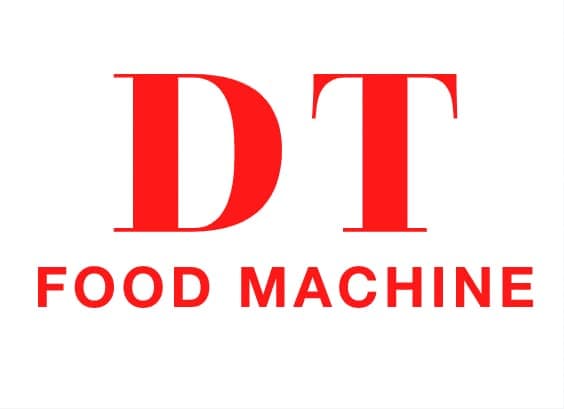Introducere: Embracing Automation in Pasta Production
In the modern era of food manufacturing, Cererea de eficiență, de încredere, Și sistemele de producție de paste de mare capacitate au crescut exponențial. Food manufacturers are increasingly turning to fully automatic commercial pasta making machine to streamline their operations, Reducerea muncii manuale, și mențineți calitatea constantă a produsului. This comprehensive guide delves into the intricacies of these machines, helping manufacturers understand the technology, avantaje, and how to choose the right solution for their production needs.
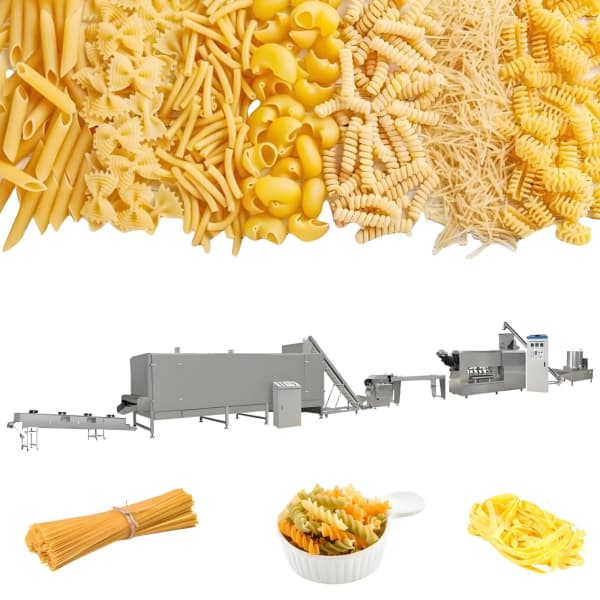
Cuprins
- Overview of Commercial Pasta Production
- What Is a Fully Automatic Commercial Pasta Making Machine?
- Types of Pasta Made by Commercial Machines
- Core Components of a Fully Automatic Pasta Machine
- Working Principle and Automation Flow
- Technical Specifications and Parameters
- Pasta Shapes and Mold Options
- Benefits of Using a Fully Automatic Pasta Machine
- Use Cases in Food Manufacturing
- Instalare, Operation & Maintenance Guide
- Quality Standards & Hygiene Compliance
- Defalcarea costurilor: Machine Price vs. Operational Cost
- Factors to Consider When Choosing a Machine
- Global Pasta Market Trends & Opportunities
- Producători de frunte & Suppliers
- Common FAQs About Commercial Pasta Machines
- Real-World Case Study: From Manual to Fully Automatic
- Concluzie
1. Overview of Commercial Pasta Production
Commercial pasta production involves large-scale operations that require speed, consistență, și igienă. Pasta has become a global staple, from Italian spaghetti to Asian-style noodles. With increasing consumption across continents, the need for automated systems that meet the demands of food safety and productivity is more vital than ever.
2. What Is a Fully Automatic Commercial Pasta Making Machine?
A fully automatic commercial pasta making machine is an industrial-grade equipment designed to produce various types of pasta with minimal human intervention. These machines handle all stages—from mixing ingredients, kneading dough, extruding pasta, tăiere, uscare, to packaging—ensuring seamless and continuous production.
3. Types of Pasta Made by Commercial Machines
These versatile machines can produce:
- Spaghete
- Macaroane
- Penne
- Fusilli
- Lasagna sheets
- Paste din coajă
- Tagliatelle
- Capellini
- Fettuccine
Different dies and cutting systems enable producers to create a wide variety of pasta shapes and textures.
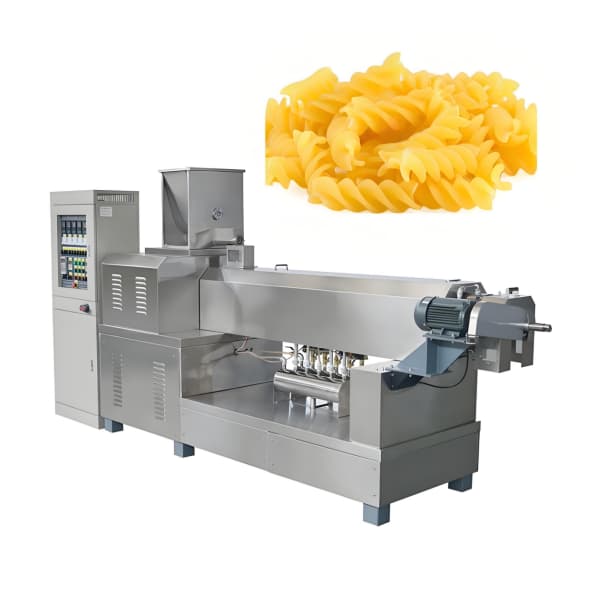
4. Core Components of a Fully Automatic Pasta Machine
A complete commercial pasta line typically includes:
- Mixing system: Combines flour and water (or eggs) into a homogenous dough.
- Vacuum kneading chamber: Removes air bubbles for perfect consistency.
- Extruder with die plates: Shapes the dough into desired pasta forms.
- Cutter/blade: Precisely trims pasta to required length.
- Camera de uscare: Controls temperature and humidity for shelf stability.
- Cooling tunnel: Prevents post-drying condensation.
- Unitate de ambalare (opțional): Seals and labels the final product.
5. Working Principle and Automation Flow
- Ingredient Feeding: Dry and wet ingredients are automatically fed into the mixer.
- Dough Formation: The ingredients are mixed and kneaded to optimal consistency.
- extrudare: Dough is extruded through interchangeable dies.
- Tăiere: Pasta is cut to predefined sizes.
- Drying/Cooling: Product passes through programmable drying and cooling phases.
- Ambalaj: Optional integration with packaging machinery for ready-to-sell products.
6. Technical Specifications and Parameters
| Parametru | Interval de specificații |
|---|---|
| Capacitate | 100 kg/h la 2000 kg/h |
| Consumul de energie | 15 - 75 kW |
| Voltaj | 220V/380V, 50/60Hz |
| Material | Oţel inoxidabil 304/316 |
| Pasta Type | Short-cut / Long-cut |
| Controlul temperaturii | Automatic PID system |
| Drying Time | 2–6 hours adjustable |
| Nivel de zgomot | < 75 dB |
| Control Interface | Ecran tactil PLC |
7. Pasta Shapes and Mold Options
The flexibility of a pasta making machine largely depends on the mold/die selection. Food manufacturers can switch between molds in minutes, thanks to modular design. Some common die types:
- Bronze dies for traditional texture
- Teflon-coated dies for smooth pasta
- Custom-designed shapes for branding
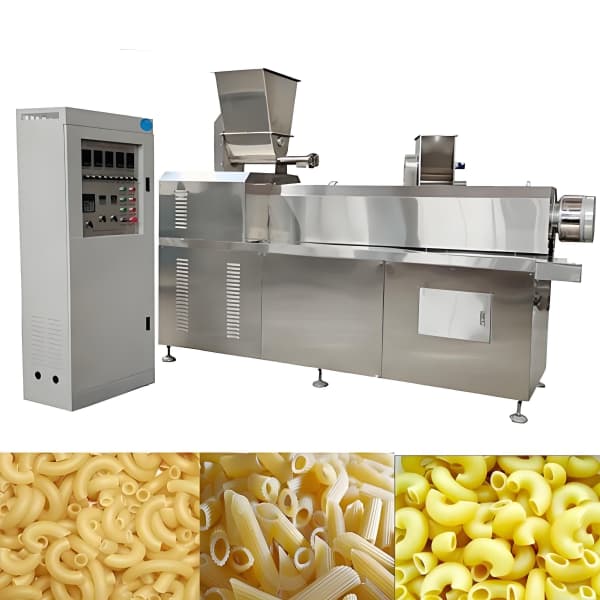
8. Benefits of Using a Fully Automatic Pasta Machine
- Labor Savings: Reduces manpower by over 70%.
- Consecvență: Every batch has uniform size and texture.
- Viteză: High output meets increasing demand.
- Siguranța alimentelor: Hygienic stainless-steel build meets HACCP standards.
- Personalizare: Enables production of branded or niche pasta types.
9. Use Cases in Food Manufacturing
- Large-scale pasta factories
- Ready-to-eat meal producers
- Catering and institutional food suppliers
- Export-focused pasta brands
- OEM pasta production lines
10. Instalare, Operation & Maintenance Guide
Instalare:
- Requires level flooring and stable power supply.
- Machine should be installed in a clean, ventilated space.
Operation:
- Operators use a touchscreen to control batch parameters.
- Recipes can be saved for repeated production.
Întreţinere:
- Daily cleaning recommended for hygiene.
- Monthly inspections of gearboxes, Curele, and bearings.
- Annual replacement of high-wear parts.
11. Quality Standards & Hygiene Compliance
- CE certification for European markets
- FDA-compliant food contact materials
- ISO 9001 production management
- Cip (Curăţare la faţa locului) optional for certain models
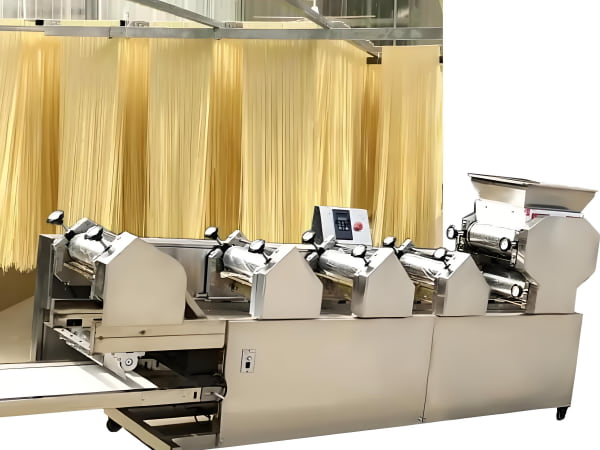
12. Defalcarea costurilor: Machine Price vs. Operational Cost
Initial Machine Cost:
| Capacitate | Gama de prețuri (USD) |
|---|---|
| 100–200 kg/h | $18,000–$35,000 |
| 500–1000 kg/h | $50,000– 95.000 USD |
| 1500–2000 kg/h | $120,000–$180,000 |
Costuri de exploatare:
- Energy: ~$0.10–0.15 per kg
- Muncă: 1–2 operators per shift
- Întreţinere: $1,500–$5,000/year
13. Factors to Consider When Choosing a Machine
- Target pasta types and capacity
- Floor space and power supply
- Budget and ROI timeline
- Nivel de automatizare (semi vs. complet automată)
- After-sales support and spare parts availability
14. Global Pasta Market Trends & Opportunities
- Rising demand for gluten-free and vegan pasta
- Surge in ready-to-cook packaged pasta
- Growth of private label pasta brands
- Technological advancements in drying systems
- Opportunities in export to Asia, Africa, și America Latină
15. Producători de frunte & Suppliers
- DT Food Machine Co., Ltd. (China)
- Specialist in high-speed, fully automatic pasta lines.
- Custom molds and turnkey solutions.
- Grupul Pavan (Italia)
- Pioneer in drying systems and short pasta lines.
- Bühler (Elveţia)
- Premium European supplier with global support.
- Italgi (Italia)
- Mid-range commercial machines, suitable for SMEs.
16. Common FAQs About Commercial Pasta Machines
Q1: Can the machine handle gluten-free flour?
A1: Da, with recipe adjustments and special screw designs.
Q2: What is the shelf life of pasta produced?
A2: 12–24 months depending on drying parameters.
Q3: Do I need a separate dryer?
A3: Nu neapărat. Many automatic systems include integrated drying tunnels.
Q4: Can I make fresh pasta with these machines?
A4: Da, with a refrigerated packaging system or short-drying cycle.
17. Real-World Case Study: From Manual to Fully Automatic
Company Profile:
- Locaţie: São Paulo, Brazilia
- Produs: Short-cut dry pasta
- Capacity before upgrade: 150 kg/zi
- After machine installation: 1000 kg/zi
- ROI achieved: În 14 luni
Impact:
- Labor reduced from 5 la 2 staff
- Reduced waste by 40%
- Expanded to international markets
18. Concluzie
A Mașină de fabricare a pastelor comerciale complet automate pentru producătorii de produse alimentare is not just a tool—it’s a gateway to scaling operations, ensuring food quality, and meeting the ever-growing demands of modern consumers. Whether you’re launching a new pasta line or upgrading your facility, investing in such a machine ensures that you’re ready for the future of food manufacturing.
